
The Ethereum Merge Explained In Plain F**king English
If you’re even vaguely into crypto, then the odds are that you’ve probably heard of the upcoming Ethereum Merger. Better known simply as the “Merge,” the event is slated to go down on September 15. Maybe.
Some say it will change the face of crypto forever. Others say it’s a terrible idea. Most don’t quite understand exactly what the hell’s going on one way or another.
Sure, a quick Google search will pull up plenty of articles about the whole thing. But most of them are chocked full of enough tech lingo to make the average reader’s head spin.
That’s why we’ve decided to break the Merge down elementary school style.
Blockchain basics
Before you can understand what’s about to happen with Ethereum, it’s important to understand exactly what it is.
Ethereum is a blockchain. While there are now many different blockchains, Ethereum ranks as one of the largest, second only to Bitcoin.
Just as countries around the world have their native currencies, many blockchains have their native tokens. Ethereum’s native token is called Ether or ETH.
But what exactly is a blockchain?
If you’re the visual type, then think of a blockchain as a bigass record or ledger of crypto transactions. Instead of pages, this record consists of units called “blocks.”
But not just anyone can add a new block. If they could, the whole thing would be full of fraudulent transactions and chaos.
That’s why there are people all over the world called miners. Think of them as somewhere between blockchain hall monitors and guardians.
Before new transactions can be added to the almighty blockchain, they must first be voted on by a group of miners.
Each time a new block is proposed, a set of miners look it over and vote on whether or not to approve it. As long as the majority of miners are honest, the block should be confirmed with no issues.
In exchange, the miners earn a nice chunk of change in cryptocurrency. The whole setup is designed to stick it to the man by completely cutting centralized banks out of the traditional financial process.
A miner dilemma
You’re not alone if getting paid to sit around verifying crypto transactions sounds like an awesome side hustle to you. Since the inception of crypto, miners have cropped up all over the world.
But what’s to keep sketchy miners from stuffing the ballots to vote in their shady crypto transactions? How does Ethereum decide who is worthy of mining new blocks in the first place?
These are the questions at the very heart of the Merge.
When Vitalik Buterin first launched Ethereum in 2015, he decided to use a similar miner vetting process as Bitcoin. This process is known as proof-of-work (PoW) and works a little something like this:
When a new block appears for validation, miners have to compete for the right to vote on it by solving something called a hash. To keep things as simple as possible, think of a hash as an insanely complex puzzle.
These puzzles would take the average human about a billion years to solve, so miners rely on their computer set-ups to do it for them. As you can imagine, having the right equipment to compete realistically requires a hell of an investment and more than a little technical know-how.
While plenty of miners have stepped up to the plate, their enthusiasm has created a major issue. All that equipment and complex puzzle solving require a boatload of electricity.
How much are we talking about?
According to Fortune, a single ETH transaction currently requires about as much energy as the average U.S. household uses in a week. It also leaves behind a carbon footprint bigger than that of over 100k Visa credit card transactions.
Yikes.
In essence, the more popular Ethereum grows, the bigger an environmental nightmare it’s become.
That’s why crypto has gotten such a bad rap over the past few years from environmental advocates. The Merge is all about reforming this rap by replacing PoW with a more sustainable option.
Enter Proof-of-Stake (PoS)
Ethereum’s developers have been well aware of its status as an energy-chugging disaster since the blockchain’s creation. That’s why they’ve been hard at work on a PoW alternative called Proof-of-Stake (PoS).
By shifting to PoS, Ethereum will be able to cut its energy usage by 99.95%. So why didn’t they just do that all along?
Unfortunately, developing a solid PoS system has proved incredibly complicated. While Ethereum has prepared to pull the trigger a few times already, it’s had to delay the Merge several times…until now.
Once PoS is instituted, miners around the world will no longer have to use a ridiculous amount of energy solving puzzles. In fact, ETH has announced that they’ll no longer be called miners but “validators.”
When a PoS validator wants to do a little validating, they’ll have to stake tokens to compete for the chance. This works like a traditional lottery where people throw tickets into a hat for a chance to win a prize.
Instead of tickets, validators will have to toss their own tokens into the metaphorical hat. The more tokens they toss in, the more chance they have to win the right to validate a block.
But here’s the kicker. In order to enter at all, you’ll have to stake at least 32 ETH, which currently works out to nearly $50k. The good news is that you won’t need to spend even more money on a huge mining rig and killer electric bills.
Where does the “merge” part come in?
So why is the shift from PoW to PoS called the Merger in the first place? It goes back to the difficulty of shifting from PoW to PoS overnight.
In order to pull it off, Ethereum has had to develop two separate blockchains. The first is the “mainnet,” which is what Ethereum has been operating on since its debut.
Then there are a series of “testnets,” which are separate Ethereum blockchains that only developers have access to. Testnets are used to test drive new ideas so that if they crash and burn, they won’t take the mainnet down with them.
In late 2020, Ethereum’s developers created a new blockchain called the beacon chain that fully runs on a PoS system. Ever since they’ve been running testnet transactions through it to ensure the whole thing isn’t one big dumpster fire waiting to happen.
Now that the beacon chain has proven itself worthy, they’re ready to use it in a real-world scenario.
At the moment, the Ethereum mainnet and beacon chain are both out there running like two parallel roads. The Merge will see them come together as one.
The plan is to take all the data on the Ethereum mainnet and transfer it over to the beacon chain, doing away with PoW once and for all.
Will the Merge affect the price of ETH?
In true crypto fashion, no one can say exactly how or even if the Merge will affect the price of Ethereum.
Some say the Merge will go a long way in boosting ETH’s popularity. The 99.95% energy cut alone will solve one of the biggest ethical concerns many would-be investors have traditionally had with crypto.
Pro-Mergers also argue that the new PoS system will allow more regular people to participate in the validation process. Overall, fans of the Merge believe that ETH is about to get a lot more efficient, cheaper, and easier to use.
On the other hand, Merge nay-sayers have plenty of arguments of their own. The first is the obvious possibility that something will go terribly wrong.
Maybe the Merge won’t work and will instead accidentally create two parallel ETHs. Maybe the whole thing will result in a crypto Civil War of epic proportions.
Maybe.
But in all likelihood, things won’t be quite so dramatic, given the years of careful planning behind the Merge.
Another big argument among critics is that the Merge will render ETH a security, placing it squarely in the crosshairs of the SEC. It’s only a matter of time, they argue, before ETH takes the decentralization out of decentralized finance.
Then, of course, there are the scores of pissed-off miners who are about to be rendered more or less obsolete. Investing in an expensive mining set-up may have made sense when it was a requirement to mine.
But now that anyone with enough tokens can join validate transactions, many miners feel like their initial investments are about to disappear.
The bottom line is that there’s no telling how the Merge will affect the price of ETH. While it may end up being a make-or-break moment in the annals of Ethereum history, only time will tell whether the Merge turns out to be an awesome or questionable idea.
Sources
- https://ethereum.org/en/upgrades/merge/
- https://fortune.com/2021/07/29/ethereum-going-green-ether-crypto-carbon-footprint/
- https://arstechnica.com/tech-policy/2022/08/the-merge-the-biggest-change-in-ethereum-history-explained/
- https://www.coindesk.com/layer2/2022/08/18/ethereums-merge-will-increase-its-use-cases-and-drive-its-investment-narrative/
- https://www.coindesk.com/tech/2022/08/10/whats-at-stake-will-the-merge-turn-ether-into-a-security/




